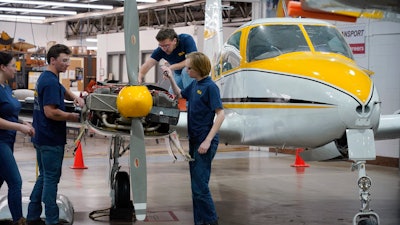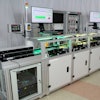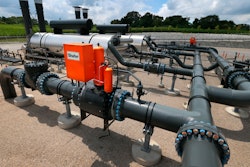
WASHINGTON (AP) — Kwasi Bandoh, a senior recruiter for an airline, stood before a group of aviation mechanic students at their graduation ceremony last month and congratulated them for all having jobs.
As some of the students began nudging each other, Bandoh realized that perhaps not every one of them had already been hired.
"Who doesn't have a job?" Bandoh demanded, surveying the 15 graduates before him at the Pittsburgh Institute of Aeronautics' training facility in Hagerstown, Maryland. "Who doesn't? Because I have a job for you."
The crowd of about 70 friends and relatives, gathered in a hangar where the students had been trained, laughed appreciatively. Fourteen of the 15 graduates did have jobs, and the only one who didn't had an interview lined up for the next day.
As happy as the moment was for the graduates, it epitomized the struggles of recruiters like Bandoh, who are desperately seeking mechanics for the airlines, plane manufacturers and repair shops that need them. Most of their existing mechanics are aging, and demand for travel is growing.
Across the U.S. economy, other industries, too, face the same formidable challenge: Replenishing a workforce diminished by a surge of retirements that began during the pandemic and has continued since. It's a growing problem in such fields as construction, manufacturing, nursing and some professional industries like accounting.
Since 2019, the proportion of retirees in the U.S. population has risen from 18% to nearly 20%, according to research by the Federal Reserve Bank of New York — equivalent to about 3.5 million fewer workers. And the trend seems sure to accelerate: The percentage of workers who are 55 or older is nearly 24%, up from only about 15% two decades ago.
The surge of retirements, along with a slowdown in immigration that began during the pandemic, are the primary factors behind the labor shortages that continue to bedevil some employers.
The aging workforce also helps explain the confounding nature of the economy right now. Even as the Federal Reserve has relentlessly pumped up interest rates to fight high inflation, hiring has remained surprisingly robust. Regardless of where interest rates are, many employers simply need to replace people who have left.
 Students at the Pittsburgh Institute of Aeronautics Nikki Reed, center, and William Onderdork study the engine on an Cessna 310 aircraft in West Mifflin, Pa., Tuesday, May 2, 2023. Students graduating from PIA have been awed by how much they're in demand.AP Photo/Gene J. Puskar
Students at the Pittsburgh Institute of Aeronautics Nikki Reed, center, and William Onderdork study the engine on an Cessna 310 aircraft in West Mifflin, Pa., Tuesday, May 2, 2023. Students graduating from PIA have been awed by how much they're in demand.AP Photo/Gene J. Puskar
Job growth has been stronger, in fact, than economic growth would suggest. The economy expanded at a mediocre 1.3% annual rate in the first three months of 2023. Yet hiring was robust, averaging nearly 300,000 jobs a month. In April, the unemployment rate reached a half-century low of 3.4%. On Friday, the government will issue the May employment report, which economists predict will show another solid gain of about 190,000 jobs.
Companies that must fill jobs tend to raise pay to attract and keep workers — a trend that can fuel inflation as those same employers typically raise their prices to cover their higher labor costs. That dynamic is complicating the Fed's efforts to tame inflation.
In the airline industry, more than one-third of mechanics are between 55 and 64, according to government data. Fewer than one in 10 are under 30.
"Everybody's getting ready to retire, and not enough people are coming in to take the jobs," said Mike Myers, a maintenance manager for Piedmont Airlines, in Hagerstown, a regional feeder for American Airlines.
The new graduates of the Pittsburgh Institute of Aeronautics have been awed by how much they're in demand. One of them, Will Gower, said he weighed multiple job offers at nearly twice the $15-an-hour wage he had earned at the retail job he held while in school.
"It was almost overwhelming how many companies were throwing jobs at you," said Gower, 21. "Anywhere there's an airport you can go work."
Next month, Gower will join Commute Air, Bandoh's company, along with three of his classmates, and will receive further training in Houston.
In the past year, the air travel industry has hired roughly 45,000 people, enlarging its workforce by 9%, to more than a half-million. That's triple the pace of the U.S. economy's overall hiring.
United Airlines has said it plans to hire 15,000 workers this year and more in coming years. It expects to add 2,300 pilots, in part to offset about 500 retirements. Kate Gebo, United's executive vice president of human resources, said she foresees a shortage of airplane mechanics, with up to half of United's mechanics already eligible to retire.
In the construction industry, the proportion of workers ages 55 and older doubled from 2003 to 2020, to nearly one-quarter, according to the government.
Anirban Basu, chief economist for the Associated Builders and Contractors trade group, said that in addition to aging, industries like aviation maintenance and construction share another challenge: Fewer young people want to take jobs in what are often perceived as less-secure, blue-collar work.
When the now-retiring baby boomers began working, Basu said, "there was the notion that being a blue-collar tradesperson was a solid and secure path to prosperity." But as factories shut down across the country, "the notion increasingly became that for one to become part of the American middle class, one would likely need to have more formal education, namely, a bachelor's degree."
The result, he said, is an economy short of factory workers, backhoe operators, welders, electricians and other skilled trade workers.
If there's one trend that might ease, if not solve, the problem it's that Americans below retirement age have been re-entering the job market, likely drawn by steady hiring and higher pay levels. The proportion of these adults who either have a job or are looking for one now exceeds pre-pandemic levels.
Yet for now, an aging workforce remains a problem even for some white-collar jobs, particularly accounting. About three-quarters of accountants are "nearing 60" and approaching retirement, according to the Association of International Certified Professional Accountants.
Tom Hood, an executive vice president of the association, said the industry is finding it hard to attract young college graduates. Many of them prefer data science or finance, while accounting struggles with a stuffier, more old-fashioned image.
"We're getting squeezed from the older part and the younger part as well," Hood said.
Nela Richardson, chief economist at the payroll provider ADP, said research shows that countries that have many retirees who spend money and consume and have fewer people working typically face higher inflation. In those countries, demand for goods and services tends to exceed the supply.
"This is the missing piece in terms of our dialogue about, can the Fed drive inflation back down to" its 2% target? Richardson said.
Some economists have said they worry that the job market's resilience, and the resulting fear that inflation will remain high, will lead the Fed to send its benchmark rate even higher, which could derail the economy and cause a recession.
Gower, who is from Covington, Louisiana, near New Orleans, isn't exactly worried about a recession. His new job as a line mechanic at Commute Air will pay $30 an hour to start, plus higher wages for night shifts.
"We've all got great futures ahead of us," he said.
Brian Prentice, a partner at the OliverWyman consulting firm, estimates that the aviation industry will endure a shortage of up to 18,000 mechanics this year — about 12% of current staffing levels. It will likely boost pay levels across the industry.
Mindy Pavlonis, associate director of career services for the aeronautics institute, noted that entry-level pay has jumped from about $18 an hour in 2018 to the upper-$20s an hour now.
More financial aid for young people to receive training can help address the worker shortfall, Prentice said, a benefit that some airlines are starting to provide. Myers, the manager at Piedmont, said his company now offers scholarships that pay full tuition to schools like the Pittsburgh Institute of Aeronautics. In return, the student must work at Piedmont for two years.
They will even set up new students with a $6,500 tool box, he added.
Erik Hansen, a lobbyist for the U.S. Travel Association, says his group is pushing for more funding for a federal development program that would subsidize aviation maintenance training schools and support more outreach to high schools to promote the industry as a career.
Without more workers, he said, further flight delays will inevitably result.
"You have an airplane that has a mechanical issue, and it needs to be fixed before it's turned around," Hansen said. "It takes longer for the mechanics to get to it. There's going to be a flight delay. So it's absolutely something we need to address."






















